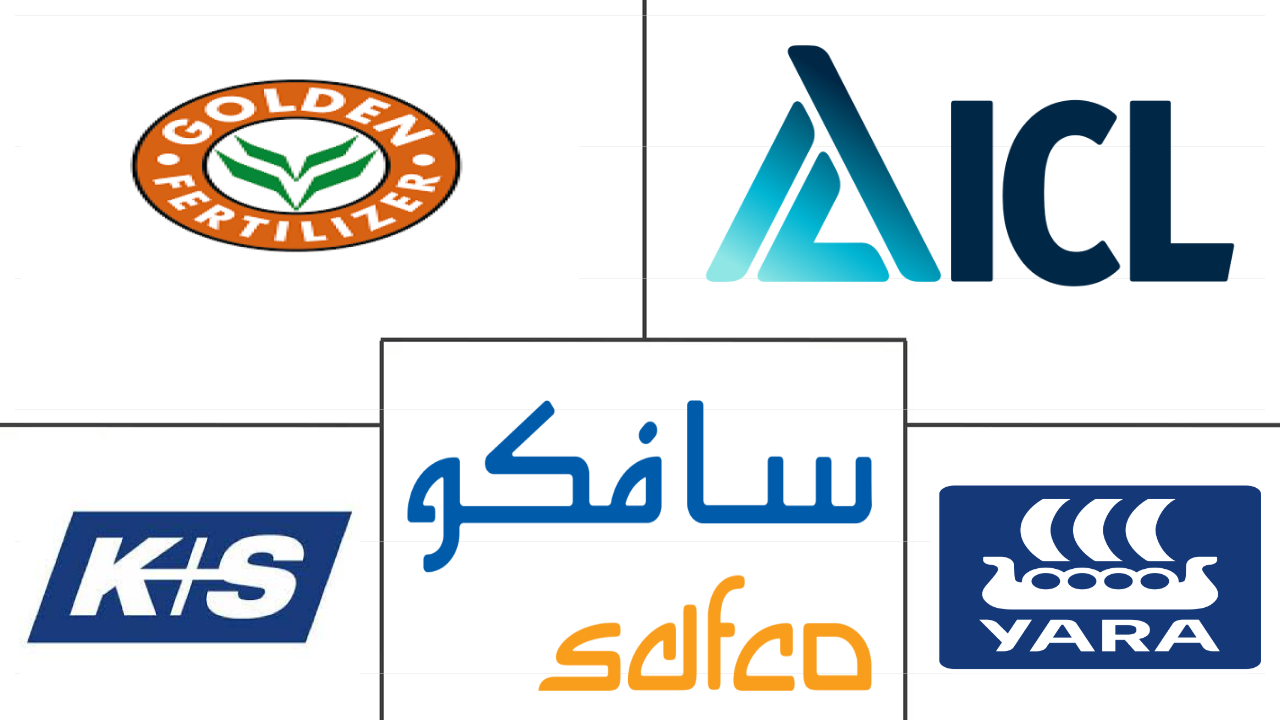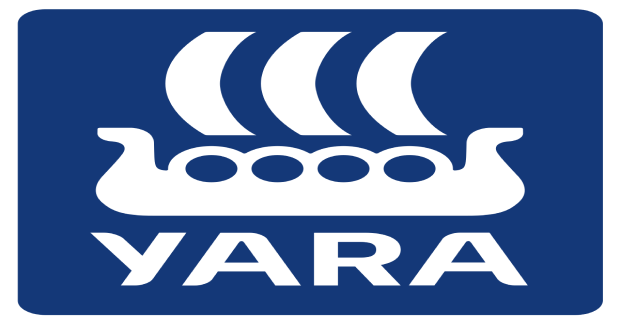Market Size of middle east & africa fertilizers Industry
|
|
Study Period | 2017 - 2030 |
|
|
Market Size (2024) | USD 51.38 Billion |
|
|
Market Size (2030) | USD 77.84 Billion |
|
|
Largest Share by Crop Type | Field Crops |
|
|
CAGR (2024 - 2030) | 7.17 % |
|
|
Largest Share by Country | Nigeria |
Major Players |
||

|
||
|
*Disclaimer: Major Players sorted in no particular order |
MEA Fertilizers Market Analysis
The Middle East & Africa Fertilizers Market size is estimated at 51.38 billion USD in 2024, and is expected to reach 77.84 billion USD by 2030, growing at a CAGR of 7.17% during the forecast period (2024-2030).
51.38 Billion
Market Size in 2024 (USD)
77.84 Billion
Market Size in 2030 (USD)
8.53 %
CAGR (2017-2023)
7.17 %
CAGR (2024-2030)
Largest segment by Product
24.50 %
value share, Urea, 2023
The urea fertilizer market in Africa is witnessing an upward trajectory, with the advent of more environmentally friendly and efficient urea formulations.
Largest Segment by Crop Type
61.79 %
value share, Field Crops, 2023
The expanding area under sulfur-dependent field crops like corn and cotton cultivation in the region and the need for their higher crop yields may drive the market.
Fastest Growing Speciality Type
7.94 %
Projected CAGR, CRF, 2024-2030
The demand to develop environmentally safe and high-efficiency fertilizers that give better yields is growing, which is driving the segment's growth in Middle East & Africa.
Largest segment by Country
11.72 %
value share, Nigeria, 2023
Empirical studies show that Nigeria is still using fertilizers below 20kg/hectare, with the potential of applying more fertilizers, thus augmenting the market's growth.
Leading Market Player
3.47 %
market share, Yara International ASA, 2022

Yara International ASA is involved in selling, marketing, distributing, and producing fertilizers. The company markets a range of agricultural nutrition solutions, including nitrogen and compound fertilizers designed for soil application.
Field crops dominated the market owing to their larger cultivation area
- The overall fertilizer market is estimated to register a CAGR of 7.0% from 2023 to 2030. Agriculture is by far the single most important economic activity in Africa. It provides employment for about two-thirds of the continent’s working population, and for each country, it contributes an average of 30-60% of the gross domestic product and 30.0% of the value of exports.
- Africa is regarded as a key center of agricultural production because of the availability of arable land. However, only 6.0% of cultivated land in Africa is irrigated. In 2018, Sub-Saharan Africa's average fertilizer consumption stood at 17.0 kg of nutrients per hectare, significantly lower than the global average of 135.0 kg/ha.
- The Middle East predominantly cultivates staple crops like wheat and barley. Additionally, Egypt and Saudi Arabia lead in the production of rice, maize, lentils, chickpeas, vegetables, and fruits. Africa, on the other hand, boasts a diverse vegetable range, including tomatoes, onions, cabbages, peppers, okra, eggplants, and cucumbers. Notably, tomatoes and onions thrive in abundance along North Africa's coastal regions. Africa's notable beverage crops encompass tea, coffee, cocoa, and grapes.
- While the agricultural sector plays a pivotal role in economic and social development, it has not garnered sufficient attention from policymakers and stakeholders in the MENA region. Despite its modest GDP contribution, agriculture holds strategic importance for sustainable development in MENA countries, which is expected to fuel the fertilizers market in the coming years.
The growing population and concern regarding food security need to be addressed through fertilizer use in the region, drive the market
- The fertilizer market in the region is being propelled by factors such as a growing population, the need to ensure food security, the adoption of intensive agricultural practices, and nutrient deficiencies in regional soils. It is projected to witness a value CAGR of 7.0% during 2023-2030.
- Africa, with its vast arable land, boasts the highest population on the continent. For instance, the Sub-Saharan African region is home to 13% of the global population and controls roughly 20% of the world's agricultural land. However, the region grapples with significant food insecurity, largely due to its increasing reliance on fertilizers.
- Nigeria leads the fertilizer market in Africa, commanding a share of 12.7% in 2022. With over 70 blending plants and major urea production facilities, the country is poised to become a fertilizer powerhouse, even competing globally in the urea market. This surge in production has led to cost reductions and increased availability, driving higher adoption rates among farmers.
- The Middle East, known for its unfavorable climatic conditions for farming, heavily relies on fertilizer imports to meet its domestic needs. Consequently, the region witnesses a comparatively higher adoption of fertilizers to cater to both domestic and international demands.
- While fertilizers offer economic benefits and can boost yields sustainably, their usage is on the rise due to challenges like limited availability and adverse environmental conditions. The region's imperative to address the needs of a growing population and ensure food security further fuels the market's growth.
Middle East & Africa Fertilizers Industry Segmentation MEA Fertilizers Industry Segmentation
Complex, Straight are covered as segments by Type. Conventional, Speciality are covered as segments by Form. Fertigation, Foliar, Soil are covered as segments by Application Mode. Field Crops, Horticultural Crops, Turf & Ornamental are covered as segments by Crop Type. Nigeria, Saudi Arabia, South Africa, Turkey are covered as segments by Country.
- The overall fertilizer market is estimated to register a CAGR of 7.0% from 2023 to 2030. Agriculture is by far the single most important economic activity in Africa. It provides employment for about two-thirds of the continent’s working population, and for each country, it contributes an average of 30-60% of the gross domestic product and 30.0% of the value of exports.
- Africa is regarded as a key center of agricultural production because of the availability of arable land. However, only 6.0% of cultivated land in Africa is irrigated. In 2018, Sub-Saharan Africa's average fertilizer consumption stood at 17.0 kg of nutrients per hectare, significantly lower than the global average of 135.0 kg/ha.
- The Middle East predominantly cultivates staple crops like wheat and barley. Additionally, Egypt and Saudi Arabia lead in the production of rice, maize, lentils, chickpeas, vegetables, and fruits. Africa, on the other hand, boasts a diverse vegetable range, including tomatoes, onions, cabbages, peppers, okra, eggplants, and cucumbers. Notably, tomatoes and onions thrive in abundance along North Africa's coastal regions. Africa's notable beverage crops encompass tea, coffee, cocoa, and grapes.
- While the agricultural sector plays a pivotal role in economic and social development, it has not garnered sufficient attention from policymakers and stakeholders in the MENA region. Despite its modest GDP contribution, agriculture holds strategic importance for sustainable development in MENA countries, which is expected to fuel the fertilizers market in the coming years.
| Type | |||||||||||||||||||||||||||||||||
| Complex | |||||||||||||||||||||||||||||||||
|
| Form | ||||||
| Conventional | ||||||
|
| Application Mode | |
| Fertigation | |
| Foliar | |
| Soil |
| Crop Type | |
| Field Crops | |
| Horticultural Crops | |
| Turf & Ornamental |
| Country | |
| Nigeria | |
| Saudi Arabia | |
| South Africa | |
| Turkey | |
| Rest of Middle East & Africa |
Middle East & Africa Fertilizers Market Size Summary
The Middle East & Africa Fertilizers Market is poised for significant growth, driven by the region's agricultural demands and economic needs. Agriculture remains a cornerstone of the economy in Africa, providing substantial employment and contributing significantly to GDP and exports. Despite the vast arable land, the region faces challenges such as limited irrigation and low fertilizer consumption compared to global averages. The Middle East, with its focus on staple crops and reliance on imports, sees a higher adoption of fertilizers to meet both domestic and international demands. The market is further propelled by factors like population growth, the necessity for food security, and the adoption of intensive agricultural practices. These dynamics underscore the strategic importance of fertilizers in supporting sustainable agricultural development in the region.
The market landscape is characterized by a fragmented structure, with key players like Golden Fertilizer Company Limited, ICL Group Ltd, K+S Aktiengesellschaft, SABIC Agri-Nutrients Co., and Yara International ASA holding significant shares. Recent strategic acquisitions and partnerships, such as SABIC's stake in ETG and K+S's acquisition of Industrial Commodities Holdings, highlight efforts to strengthen market positions and expand operations across Africa. The emphasis on nitrogen, phosphorous, and potassium reflects the region's focus on enhancing crop yields and addressing nutrient deficiencies. As the region continues to grapple with food insecurity and environmental challenges, the fertilizers market is expected to play a crucial role in boosting agricultural productivity and ensuring economic stability.
Middle East & Africa Fertilizers Market Size - Table of Contents
-
1. MARKET SEGMENTATION (includes market size in Value in USD and Volume, Forecasts up to 2030 and analysis of growth prospects)
-
1.1 Type
-
1.1.1 Complex
-
1.1.2 Straight
-
1.1.2.1 Micronutrients
-
1.1.2.1.1 Boron
-
1.1.2.1.2 Copper
-
1.1.2.1.3 Iron
-
1.1.2.1.4 Manganese
-
1.1.2.1.5 Molybdenum
-
1.1.2.1.6 Zinc
-
1.1.2.1.7 Others
-
-
1.1.2.2 Nitrogenous
-
1.1.2.2.1 Ammonium Nitrate
-
1.1.2.2.2 Urea
-
1.1.2.2.3 Others
-
-
1.1.2.3 Phosphatic
-
1.1.2.3.1 DAP
-
1.1.2.3.2 MAP
-
1.1.2.3.3 SSP
-
1.1.2.3.4 TSP
-
1.1.2.3.5 Others
-
-
1.1.2.4 Potassic
-
1.1.2.4.1 MoP
-
1.1.2.4.2 SoP
-
1.1.2.4.3 Others
-
-
1.1.2.5 Secondary Macronutrients
-
1.1.2.5.1 Calcium
-
1.1.2.5.2 Magnesium
-
1.1.2.5.3 Sulfur
-
-
-
-
1.2 Form
-
1.2.1 Conventional
-
1.2.2 Speciality
-
1.2.2.1 CRF
-
1.2.2.2 Liquid Fertilizer
-
1.2.2.3 SRF
-
1.2.2.4 Water Soluble
-
-
-
1.3 Application Mode
-
1.3.1 Fertigation
-
1.3.2 Foliar
-
1.3.3 Soil
-
-
1.4 Crop Type
-
1.4.1 Field Crops
-
1.4.2 Horticultural Crops
-
1.4.3 Turf & Ornamental
-
-
1.5 Country
-
1.5.1 Nigeria
-
1.5.2 Saudi Arabia
-
1.5.3 South Africa
-
1.5.4 Turkey
-
1.5.5 Rest of Middle East & Africa
-
-
Middle East & Africa Fertilizers Market Size FAQs
How big is the Middle East & Africa Fertilizers Market?
The Middle East & Africa Fertilizers Market size is expected to reach USD 51.38 billion in 2024 and grow at a CAGR of 7.17% to reach USD 77.84 billion by 2030.
What is the current Middle East & Africa Fertilizers Market size?
In 2024, the Middle East & Africa Fertilizers Market size is expected to reach USD 51.38 billion.

